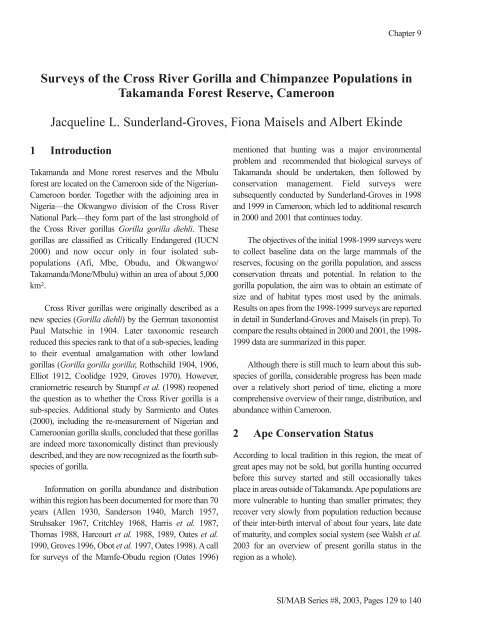Fisheries in the Southern Border Zone of Takamanda - Impact ...
Fisheries in the Southern Border Zone of Takamanda - Impact ...
Fisheries in the Southern Border Zone of Takamanda - Impact ...
Create successful ePaper yourself
Turn your PDF publications into a flip-book with our unique Google optimized e-Paper software.
Surveys <strong>of</strong> <strong>the</strong> Cross River Gorilla and Chimpanzee Populations <strong>in</strong><br />
<strong>Takamanda</strong> Forest Reserve, Cameroon<br />
Jacquel<strong>in</strong>e L. Sunderland-Groves, Fiona Maisels and Albert Ek<strong>in</strong>de<br />
1 Introduction<br />
<strong>Takamanda</strong> and Mone rorest reserves and <strong>the</strong> Mbulu<br />
forest are located on <strong>the</strong> Cameroon side <strong>of</strong> <strong>the</strong> Nigerian-<br />
Cameroon border. Toge<strong>the</strong>r with <strong>the</strong> adjo<strong>in</strong><strong>in</strong>g area <strong>in</strong><br />
Nigeria—<strong>the</strong> Okwangwo division <strong>of</strong> <strong>the</strong> Cross River<br />
National Park—<strong>the</strong>y form part <strong>of</strong> <strong>the</strong> last stronghold <strong>of</strong><br />
<strong>the</strong> Cross River gorillas Gorilla gorilla diehli. These<br />
gorillas are classified as Critically Endangered (IUCN<br />
2000) and now occur only <strong>in</strong> four isolated subpopulations<br />
(Afi, Mbe, Obudu, and Okwangwo/<br />
<strong>Takamanda</strong>/Mone/Mbulu) with<strong>in</strong> an area <strong>of</strong> about 5,000<br />
km 2 .<br />
Cross River gorillas were orig<strong>in</strong>ally described as a<br />
new species (Gorilla diehli) by <strong>the</strong> German taxonomist<br />
Paul Matschie <strong>in</strong> 1904. Later taxonomic research<br />
reduced this species rank to that <strong>of</strong> a sub-species, lead<strong>in</strong>g<br />
to <strong>the</strong>ir eventual amalgamation with o<strong>the</strong>r lowland<br />
gorillas (Gorilla gorilla gorilla; Rothschild 1904, 1906,<br />
Elliot 1912, Coolidge 1929, Groves 1970). However,<br />
craniometric research by Stumpf et al. (1998) reopened<br />
<strong>the</strong> question as to whe<strong>the</strong>r <strong>the</strong> Cross River gorilla is a<br />
sub-species. Additional study by Sarmiento and Oates<br />
(2000), <strong>in</strong>clud<strong>in</strong>g <strong>the</strong> re-measurement <strong>of</strong> Nigerian and<br />
Cameroonian gorilla skulls, concluded that <strong>the</strong>se gorillas<br />
are <strong>in</strong>deed more taxonomically dist<strong>in</strong>ct than previously<br />
described, and <strong>the</strong>y are now recognized as <strong>the</strong> fourth subspecies<br />
<strong>of</strong> gorilla.<br />
Information on gorilla abundance and distribution<br />
with<strong>in</strong> this region has been documented for more than 70<br />
years (Allen 1930, Sanderson 1940, March 1957,<br />
Struhsaker 1967, Critchley 1968, Harris et al. 1987,<br />
Thomas 1988, Harcourt et al. 1988, 1989, Oates et al.<br />
1990, Groves 1996, Obot et al. 1997, Oates 1998). A call<br />
for surveys <strong>of</strong> <strong>the</strong> Mamfe-Obudu region (Oates 1996)<br />
mentioned that hunt<strong>in</strong>g was a major environmental<br />
problem and recommended that biological surveys <strong>of</strong><br />
<strong>Takamanda</strong> should be undertaken, <strong>the</strong>n followed by<br />
conservation management. Field surveys were<br />
subsequently conducted by Sunderland-Groves <strong>in</strong> 1998<br />
and 1999 <strong>in</strong> Cameroon, which led to additional research<br />
<strong>in</strong> 2000 and 2001 that cont<strong>in</strong>ues today.<br />
The objectives <strong>of</strong> <strong>the</strong> <strong>in</strong>itial 1998-1999 surveys were<br />
to collect basel<strong>in</strong>e data on <strong>the</strong> large mammals <strong>of</strong> <strong>the</strong><br />
reserves, focus<strong>in</strong>g on <strong>the</strong> gorilla population, and assess<br />
conservation threats and potential. In relation to <strong>the</strong><br />
gorilla population, <strong>the</strong> aim was to obta<strong>in</strong> an estimate <strong>of</strong><br />
size and <strong>of</strong> habitat types most used by <strong>the</strong> animals.<br />
Results on apes from <strong>the</strong> 1998-1999 surveys are reported<br />
<strong>in</strong> detail <strong>in</strong> Sunderland-Groves and Maisels (<strong>in</strong> prep). To<br />
compare <strong>the</strong> results obta<strong>in</strong>ed <strong>in</strong> 2000 and 2001, <strong>the</strong> 1998-<br />
1999 data are summarized <strong>in</strong> this paper.<br />
Although <strong>the</strong>re is still much to learn about this subspecies<br />
<strong>of</strong> gorilla, considerable progress has been made<br />
over a relatively short period <strong>of</strong> time, elict<strong>in</strong>g a more<br />
comprehensive overview <strong>of</strong> <strong>the</strong>ir range, distribution, and<br />
abundance with<strong>in</strong> Cameroon.<br />
2 Ape Conservation Status<br />
Chapter 9<br />
Accord<strong>in</strong>g to local tradition <strong>in</strong> this region, <strong>the</strong> meat <strong>of</strong><br />
great apes may not be sold, but gorilla hunt<strong>in</strong>g occurred<br />
before this survey started and still occasionally takes<br />
place <strong>in</strong> areas outside <strong>of</strong> <strong>Takamanda</strong>. Ape populations are<br />
more vulnerable to hunt<strong>in</strong>g than smaller primates; <strong>the</strong>y<br />
recover very slowly from population reduction because<br />
<strong>of</strong> <strong>the</strong>ir <strong>in</strong>ter-birth <strong>in</strong>terval <strong>of</strong> about four years, late date<br />
<strong>of</strong> maturity, and complex social system (see Walsh et al.<br />
2003 for an overview <strong>of</strong> present gorilla status <strong>in</strong> <strong>the</strong><br />
region as a whole).<br />
SI/MAB Series #8, 2003, Pages 129 to 140

















